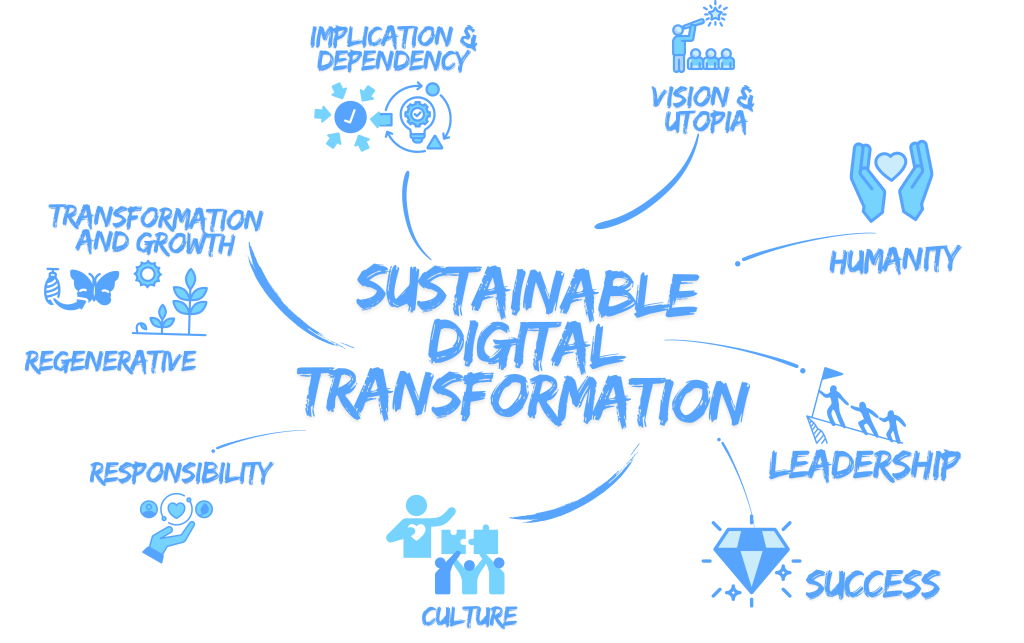Essential steps for a successful “Sustainable Digital Transformation”
With the “Sustainable Digital Transformation,” the economy and every company currently have a unique opportunity to position themselves, their products, and services as sustainable (ESG) and thus as leaders in meeting new market requirements. Digitalization, technology, and self-organized systems are the keys.
With these 13 steps, I empower people and organizations to change and position themselves in the best possible way for their future.

Even though new technologies are being used increasingly, it is not uncommon for managers to provide outdated solutions based on concepts that were successful in the past but will no longer be helpful in a faster-changing future.
Even these “traditionalists” sense that they should modernize but continue to cling to existing paradigms and approaches.
Because they know that change (especially their own) is an overwhelming task that cannot be solved alone, they try to push this by purchasing external expertise.
This intention to start the “transformation” with external help (through “fresh blood/know-how”) usually only works to a limited extent. Even the designated change agents are often only interested in change to a limited extent or are focused on just a particular section.
Sometimes, consultants do not have up-to-date objectives or only look at parts of the system. Dependencies essential for long-term success and continuous scaling are often invisible and largely ignored.
For all market player, there is still a unique opportunity to profitably change the environmental impact of their own and their company’s activities and to fundamentally reorganize global value chains. This applies to the raw materials they consume from regions at the forefront of climate change and the products and services they provide.
Sustainability and the “Sustainable Digital Transformation” are not just a trend but necessary for a company’s long-term survival. In 2024, many companies will have to account for their sustainability promises. They will realize that integrating sustainability is not just an option but a necessity for their development, relevance as an employer, resilience, and long-term success.
For many years, I have researched entrepreneurial success and how companies can become as successful as possible. Accompanying my work with many clients, I have compiled, evaluated, linked, and condensed a large number of interconnected success factors.
I aim to share a series of practical tips and learnings gradually and comprehensively. This series, ‘Essential Steps for a Successful Sustainable Digital Transformation’, will evolve into a comprehensive reference book. It will become a resource that you, as change makers, can turn to daily, empowering you to drive sustainable digital transformation in your organizations.
Learn the best practices and crucial steps for how companies can master this transformation journey and maximize the benefits of sustainability, digital transformation, and data strategy as a whole.
From green operations to mindful consumer engagement, these strategies promise a healthier planet, a resilient business (with a thriving bottom line), motivated employees, and flourishing results.

- Development of a version or utopia for your or your company’s future
- Understanding the full implications of the sustainable digital transformation
- Development of a transformative leadership mindset
- Development of a shared vision and mission
- Release a clear strategy and strategic playbook
- Initiate a personalized cultural development journey
- Elaborate a tailored data & analytics strategy (become data-driven)
- Focus on sustainable performance
- Find a joint self-evident governance
- Development of a performance-enabling architecture
- Reengineering and transformation of the organization, processes, and infrastructure
- Digitization of your (data) value chain
- Report and Communicate results, decisions, and their decision-making basis
It should be noted that each step has several sub-aspects and components from business and IT.
Basic principles and governance are required for an efficient transformation journey and each step.
These should be formulated before the individual steps and their specific content are addressed so everyone involved can orientate and align themselves to them. Only if everyone follows the corresponding principles will their actions lead to the desired effects.
The principles and governance apply to each step and sub-step. What these look like will be part of elaborating the respective “Essential step.”
For the principles and governance to be effective, they must be firmly anchored in the leaders’ minds.
Recommended procedures will be part of “personalized cultural development journey.”
What’s next?
In my next posts, I will go into detail about each step.
Together, we can work towards making positive changes and achieving great things. So please don’t hesitate to share your questions, suggestions, prioritization requests, likes, and comments.
In my next posts, I will describe each step in more detail, initially only on a very condensed level and later in various detailed descriptions.
I will soon be surveying to determine the order of which steps I will cover next and which parts I will go into in more detail.

